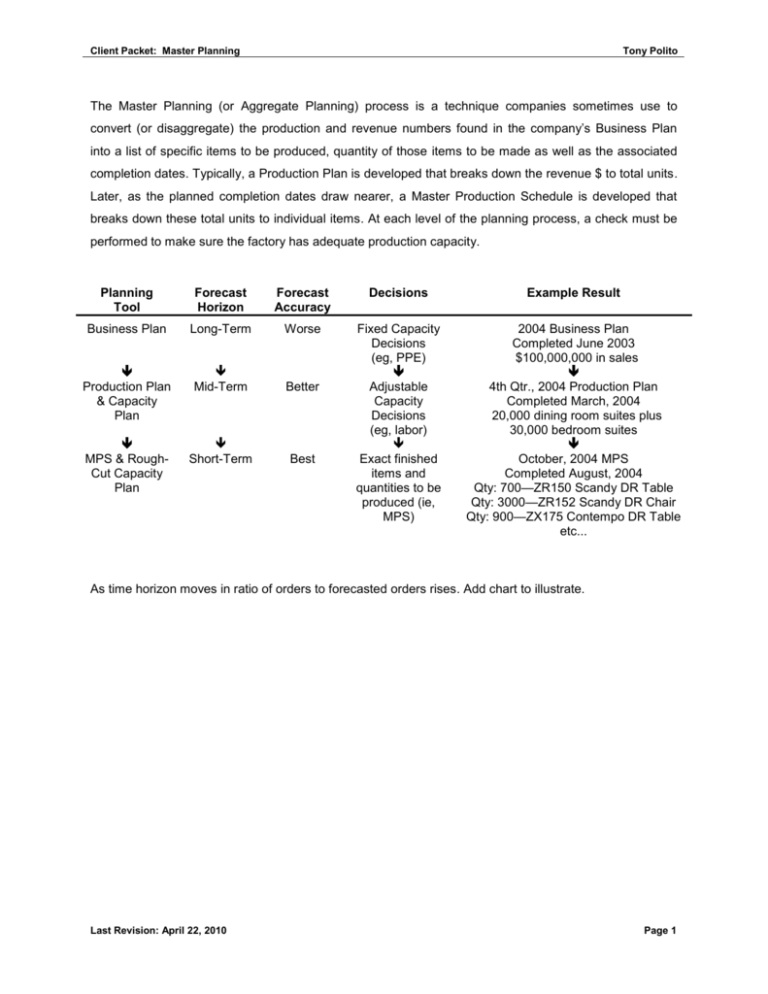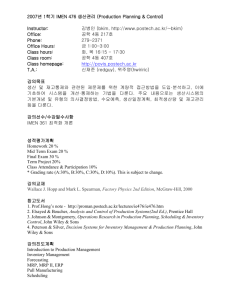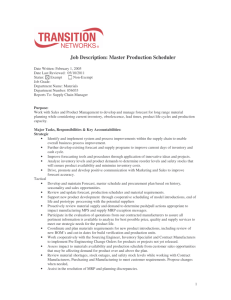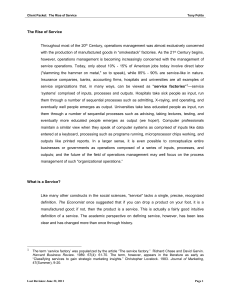Master Planning
advertisement

Client Packet: Master Planning Tony Polito The Master Planning (or Aggregate Planning) process is a technique companies sometimes use to convert (or disaggregate) the production and revenue numbers found in the company’s Business Plan into a list of specific items to be produced, quantity of those items to be made as well as the associated completion dates. Typically, a Production Plan is developed that breaks down the revenue $ to total units. Later, as the planned completion dates draw nearer, a Master Production Schedule is developed that breaks down these total units to individual items. At each level of the planning process, a check must be performed to make sure the factory has adequate production capacity. Planning Tool Forecast Horizon Forecast Accuracy Decisions Example Result Business Plan Long-Term Worse Production Plan & Capacity Plan Mid-Term Better MPS & RoughCut Capacity Plan Short-Term Best Fixed Capacity Decisions (eg, PPE) Adjustable Capacity Decisions (eg, labor) Exact finished items and quantities to be produced (ie, MPS) 2004 Business Plan Completed June 2003 $100,000,000 in sales 4th Qtr., 2004 Production Plan Completed March, 2004 20,000 dining room suites plus 30,000 bedroom suites October, 2004 MPS Completed August, 2004 Qty: 700—ZR150 Scandy DR Table Qty: 3000—ZR152 Scandy DR Chair Qty: 900—ZX175 Contempo DR Table etc... As time horizon moves in ratio of orders to forecasted orders rises. Add chart to illustrate. Last Revision: April 22, 2010 Page 1 Client Packet: Master Planning Tony Polito Classic Strategies toward Aligning Capacity with Demand 1) Level Capacity Strategy: “make the same quantities all the time” J F M A M J J A S O N D Capacity Inventory Demand /Schedule Balance 50 100 50 175 100 -25 150 100 -75 100 100 -75 75 100 -50 50 100 0 50 100 50 75 100 75 100 100 75 150 100 25 175 100 -50 50 100 0 1200 1200 Advantages: 200 150 100 50 0 J F M A M J J A S O N D Plant & Employees. Planning is less difficult, No hiring/firing costs if labor-intensive operation, there is no long-term attrition 1 of skilled labor Disadvantages: Inventory and customers. Inventory levels fluctuate, inventory costs are higher, there is more backlogging of orders, ie, orders waiting to be filled 2) Chase Demand Strategy: “Make product as we need it” In cases where capacity is less difficult to change it is not uncommon to heavily manipulate capacity so that it matches (or ‘chases’) the available demand. For example, if more automobiles suddenly appear at the fraternity fund-raising car wash demanding to be washed, more fraternity brothers can be called out of the house in order to add car washing capacity! When textile and furniture companies were ‘labor-intensive’ factories, workers often found themselves ‘laid off’ one week, then working overtime the next week. Such companies employed a Chase Demand approach, changing demand by the hiring 1 A reduction in numbers, usually as a result of resignation, retirement, or death. If 1 out of every 4 freshman at Whatzzamotta U. drop out, then there is 25% first year attrition. Last Revision: April 22, 2010 Page 2 Client Packet: Master Planning Tony Polito and firing of labor.2 Temporary labor, outsourcing of work, and extra factory shifts are just a few of the many ways that management can dramatically manipulate capacity. J F M A M J J A S O N D Capacity Inventory Demand /Schedule Balance 50 50 0 175 0 T175 150 150 0 h 100 100 0 e 75 75 0 50 50 0 50 50 0 a 75 75 0 d100 100 0 150 150 0 v 175 175 0 a 50 50 0 n1200 1200 200 150 100 50 0 J F M A M J J A S O N D t The advantages and disadvantages under Chase Demand are just the opposite of those under Level Strategy: Advantages: Inventory & Customers. Inventory levels do not fluctuate, inventory costs are lower, there is less backlogging of orders; ie, orders waiting to be filled Disadvantages: Plant & Employees. Planning is more difficult, there are significant hiring/firing costs if labor-intensive operation, there is long-term attrition of skilled labor 3) Compromise Strategy: “mix the two strategies to best meet company needs" Here you have the best of both worlds … or the worst of both worlds, depending upon how you look at it. Some orders are backlogged … but not as many as under the Level Capacity approach. Inventory levels fluctuate … but not as much as under the Level Capacity approach. Planning is more difficult … but not as difficult as under the Chase Demand approach. 2 Such companies were clearly overlooking the costs of not using their plants and equipment. Since such textile and furniture companies often owned their “PP&E” outright, the costs they overlooked were not booked costs but opportunity costs. Last Revision: April 22, 2010 Page 3 Client Packet: Master Planning J F M A M J J A S O N D Capacity Inventory Demand /Schedule Balance 50 75 25 175 150 0 150 125 -25 100 100 -25 75 75 -25 50 75 0 50 75 25 75 75 25 100 100 25 150 125 0 175 150 -25 50 75 0 1200 1200 Tony Polito 200 150 100 50 0 J F M A M J J A S O N D 4) Stairstep Strategy: level capacity rate is occasionally adjusted up or down as needed. J F M A M J J A S O N D Capacity Inventory Demand /Schedule Balance 50 120 70 175 120 15 150 120 -15 100 120 5 75 60 -10 50 60 0 50 60 10 75 60 -5 100 60 -45 150 140 -55 175 140 -90 50 140 0 1200 1200 200 150 100 50 0 J F M A M J J A S O N D Stairstepping is sort of a special case of the Compromise Strategy. It offers all the advantages of the Level Capacity approach … most of the time. The disadvantages to the Level Capacity approach are encountered only at those occasions where the production rate is stepped up or stepped down. Such occasions are usually announced well in advance so that everyone has adequate time to prepare and adjust. Last Revision: April 22, 2010 Page 4 Client Packet: Master Planning Tony Polito 5) Complementary Products Strategy The classic example is lawnmowers and snowblowers. The manufacturing of lawnmowers and snowblowers is very similar. Demand for snowblowers is low in summer and high in winter; demand for lawnmowers is low in winter and high in summer. A similar situation exists for companies that specialize in the repair of heating, ventilation, and air conditioning (HVAC) equipment. Heating and air conditioning systems – and their repairs – are very similar. Demand for heating repair is low in summer and high in winter; demand for air conditioner repair is low in winter and high in summer. 6) Manipulation of Demand Strategy In cases where capacity is fixed or very difficult to change it is not uncommon to manipulate demand so that it matches the available capacity: The number of seats in a theatre for the 7 p.m. show or on an airplane scheduled to leave at 7 p.m. cannot be changed. The seats are “wasting assets;” they cannot be inventoried and if they are not used, they will become worthless. Demand is manipulated to match the available capacity through discount pricing. The capacity of a electrical power plant is fixed; it produces a given amount of electricity per hour. Excess electricity produced cannot be inventoried. Electric companies manipulate demand by offering discounts to customers who use electricity in off-peak periods instead of peak periods, such as running the water heater only during the middle of the night. A furniture company with an idle table factory can loosen credit requirements for table purchases in order to increase demand; additional credit losses due to granting riskier credit may well be small compared to the cost of an idle factory. 3 3 Many companies reward credit managers for reducing credit losses. This is based on the Tayloristic assumption that if every department is doing its best (ie, locally optimized), then the entire company is doing its best (ie, globally optimized). That assumption is untrue, as you can easily see from this example. Here, the credit manager must raise credit losses for the company for the company to do better. All the parts of a system must work together, must cooperate, to accomplish the aim of the system. Last Revision: April 22, 2010 Page 5 Client Packet: Master Planning Tony Polito There was a time (a long, long time ago but still in this galaxy) when McDonald’s did not serve breakfast. Their kitchen capacity was fixed at 24 hours per day – the building was there day and night -- but the kitchen was unused for about half that time. McDonald’s invented a breakfast menu that was very similar in nature to their lunch/dinner menu and began to use more of that fixed kitchen capacity. MRP, MRP II and ERP MRP stands for Material Requirements Planning. You have been introduced to the basic concepts underlying MRP via a quiz. MRP II, on the other hand, stands for Manufacturing Resource Planning. MRP II extends the logic of MRP into other areas of the corporation, most notably finance. Suppose that we run a tractor-building company and it buys tractor engines from a supplier that charges $10,000 each for them and expects payment on delivery. Knowing this, if our MRP calculations tell us that five tractor engines will be needed on Tuesday, we can tell the Finance department that there will be a demand for “cash out” $50,000 on Tuesday. Likewise if we know from the Master Production Schedule that we will be delivering 10 tractors to customers on Wednesday (at a price of $100,000 each with payment due on delivery), then we can tell the Finance department that there will be “cash in” $1,000,000 on Wednesday. Hopefully, the Finance department would use this information as the basis for making cash flow projections and determining its working capital requirements. MRP II software contains MRP and MPS modules as well as financial modules that communicate such information to each other automatically. Enterprise Resource Planning (ERP) software, a concept that originated in the 1990s, extends the idea of software modules that communicate with each other and attempts to coordinate the activities and planning of the entire company (ie, “enterprise”) through a single software package. ERP software systems contain modules to support the activities of human resources, customer order processing, inventory management, purchasing, shipping, warehousing and receiving as well as manufacturing and finance. In the past, all these functions have often been computerized using different software packages and different software vendors, but companies have encountered great difficulties in trying to enable the various different software packages to share information. ERP software vendors such as Baan, Oracle, Peoplesoft, SAP and J.D. Edwards (sometimes referred to in unison as “JBOPS”) endeavor to deliver one fully integrated software package to coordinate all these functions with each other. UPDATE: J.D. Edwards was bought by PeopleSoft. Peoplesoft was bought by Oracle. Oracle sells J.D. Edwards, PeopleSoft and Oracle branded software. Baan was bought by SSA and Baan’s products were renamed SSA. SSA was later bought by Infor Global Solutions of Atlanta. Infor now sells its various ERP products (including the product formally known as MAPICS) under its own name. Currently, ERP Last Revision: April 22, 2010 Page 6 Client Packet: Master Planning Tony Polito software vendors with significant market share include SAP, Oracle, The Sage Group and Infor Global Solutions. Many companies, especially those associated with the automobile industry successfully implemented MRP during the 1970s, During the 1980s, however, about half of all attempts to implement MRP and/or MRP II failed. So far, the evidence indicates a similar rate of implementation failure (or high difficulty) for ERP systems. Last Revision: April 22, 2010 Page 7






